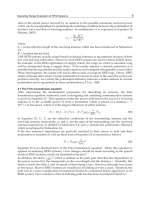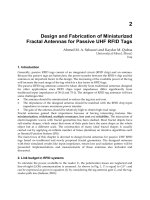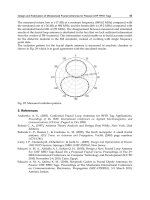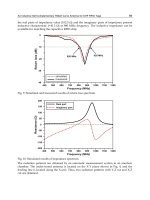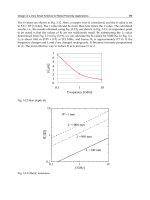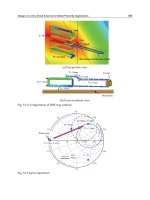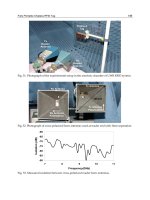Radio Frequency Identification Fundamentals and Applications, Bringing Research to Practice Part 15 pdf
Bạn đang xem bản rút gọn của tài liệu. Xem và tải ngay bản đầy đủ của tài liệu tại đây (279.12 KB, 6 trang )
An Efficient Approach for Data Transmission in RFID Middleware
273
4.3 SOAP expansion on Web Services server
On the Web Services server side, we expand the communication process by the following
algorithm, and it is illustrated in Fig. 6.
Fig. 6. Algorithm on Web Services server
5. Experiments
We construct the following environment to test our approach. The mobile client side adopts
PDA, which installs J2ME and the Wireless Toolkit 2.5.2 development tool. The server side
installs the Intel Pentium 4 CPU, 3.0GHz, 768MByte RAM, Bandwidth 100Mbps, and
Microsoft Server 2003 operating system, and Dot Net SOAP Engine expansion system, IIS
Receive a SOAP message;
Access Server_Context_Store;
Compare the ID with ID in SOAP message;
If matched
The arbitration module assembles SOAP;
Else
{
The arbitration module receives a whole message;
Deserialize the SOAP message;
Serialize the SOAP message;
Send Soap Body;
}
Radio Frequency Identification Fundamentals and Applications, Bringing Research to Practice
274
6.0. Under such configuration, the result of our experiment is shown in Fig.7. The result in
an Internet mobile computing environment is indicated in Fig.8.
Fig. 7. Comparisons under Wireless LAN
Fig. 8. Comparisons under mobile computing environment
0
1
2
3
4
5
6
100 200 400 800
1600
XML Load
(
KB
)
Normal
Compress
Context-
Store(First)
Context
-
Store
(Non-First)
Average Response Time(mesc)
0
0.5
1
1.5
2
2.5
3
3.5
4
4.5
5
100
200
400
800
1600
XML Load (KB)
Average Response Time(mesc)
Normal
Compress
Context-
Store(First)
Context-Store
(Non-First)
An Efficient Approach for Data Transmission in RFID Middleware
275
We packed several SOAP messages in the length of 100, 200, 400, 800, 1600 Kilo Bytes with
the contents of Production ID, material, tested date and so on. Under the methods of normal
SOAP transmission, Compressing and our Context-Store transmission, all the average
response time increases as the length of the SOAP message augments. But apparently, our
Context-Store approach has the least time cost compared with the other 2 methods. For the
Compressing method, due to the plenty of time consumed by CPU and the limited
processing ability, the performance becomes worse even though it cost less time in data
transmission. For the Context-Store approach, owing to the only dynamic part of SOAP
message transmission, the average response time reduces. In other words, our approach
greatly enhances the performance of SOAP message transmission efficiency.
6. Application
Based on the above design and experiments, the prototype system has been implemented
and applied to production lines in a manufactory, shown in Fig. 9. In the manufactory,
Fig. 9. Application example
Radio Frequency Identification Fundamentals and Applications, Bringing Research to Practice
276
considering the noisy surroundings, the limitations of temperature and humidity and the
difficulty of network cabling, we choose PDA with RFID embedded communication module
as readers rather than wired RFID readers. The PDA access LAN through Access Point (AP)
at the frequency of 2.4GHz.While the embedded communication module exchanges data
with tags at the frequency of 902 MHz which is also of free Industrial Scientific Medical
(ISM) band. So there is no radio frequency interference. Other application softwares are
deployed as follows: working station installs Microsoft Server 2003 operating system,
Message Queue Component and Dot Net Framework2.0. The application server installs
Internet Information Services 6.0 as WEB server.
In such application scene, workers read information of products with PDA in their hands
from 1.0 meters away and record important process information into tags. Meanwhile,
through WLAN, By virtue of Web Services, the PDA clients access application server to
update process data. With our proposed approach, the performance of data exchange is
improved and the production efficiency is increased.
7. Conclusion
In this paper, we introduce the widely applied RFID middlewares with the technique of
Web Services. More importantly, we design and realize a Context-Store approach to
improve the performance of data transmission between mobile client and Web Services
server. The experiments show our approach greatly reduces the average response time of
SOAP messages, thus achieve its original goal. What’s more, the application example of the
production lines in manufactory indicates an increase of the production efficiency.
However, the symmetrical Context-Store in both mobile client and Web Service server may
lead to data inconsistency. Our future work will focus on exploring a more effective storage
structure or seek for a way of keeping data consistency.
8. Acknowledgments
This research was supported by “Ambient SoC Global COE Program of Waseda University”
from the Ministry of Education, Culture, Sports, Science and Technology of Japan and
CREST of JST, Japan.
9. References
B S Prabhu ; Xiaoyong Su & Harish Ramamurthy. (2006). WinRFID:A Middleware for the
Enablement of Radio Frequency Identification (RFID) Based Applications. In:
Mobile, Wireless and Sensor Networks: Technology, Applications and Future Directions .
John Wiley, 2006.
Christian Floerkemeier & Matthias Lampe.(2005). RFID middleware design: addressing
application requirements and RFID constraints, Proceedings of 2005 joint conference
on Smart objects and ambient intelligence: innovative context-aware services: usages and
technologies, page :219-224, ISBN:1-59593-304-2, Grenoble, France, 2005, ACM New
York.
An Efficient Approach for Data Transmission in RFID Middleware
277
Clemens Kerer; Schahram Dustdar & Mehdi Jazayeri.(2004). Presence Aware Infrastructure
Using Web Services and RFID Technologies. Proceedings of the ECOOP Workshop,
2004.
Han Chen; Paul B. Chou; Sastry Duri; Jeffery G. Elliott & Johnathan M. Reason. (2005).
A Model-Driven Approach to RFID Application Programming and Infrastructure
Management, Proceedings of IEEE International Conference on e-Business
Engineering .
Julio Fernandez;Ana Fernandez & Jose Pazos. (2005). Optimizing web services performance
using caching, Proceedings of the International Conference on Next Generation Web
Services Practices, 6 pages, 2005.
K Devaram & D Andresen. (2003). SOAP Optimization via Parameterized Client-Side
Caching, Proceedings of the IASTED International Conference on Parallel and Destributed
Computing and Systems, page : 785-790. Marina Del Reg, CA, 2003.
Mike Nikitas. (2003). Improve XML Web Services' Performance by Compressing SOAP. URI:
30 AE 2-1C79-4D5F-827E-
6C2857FF1D23.dcik, 2003.
Niranjan & Aura Ganz. (2004). REALMS-RFID Enabled Animated Space. Proceedings of
International Conference on Communication and Computer Network , MIT, MA.
Noah Mendelsohn; Mark Nottingham & Hervé Ruellan.(2004). XML-binary Optimized
Packaging W3C Working Draft. URI: />20040608/, 2004, 06.
Seshasayee B; Schwan K& Widener P. (2004). SOAP-binQ: High-Performance SOAP with
Continuous Quality Management, Proceedings of the 24th International Conference on
Destributed Computing System, page : 158-165.
Taesu Cheong & Youngil Kim. (2005). RFID Data Management and RFID Information Value
Chain Support with RFID Middleware Platform Implementation , In: On the Move
to Meaningful Internet Systems 2005: CoopIS, DOA, and ODBASE, Editors: Agia Napa,
Cyprus, page : 557-575, Publisher : Springer Berlin, ISBN : 978-3-540-29736-9,
Heidelberg Germany .
Toyotaro Suzumura;Toshiro Takase & Michiaki Tatsubori. (2005). Optimizing web services
performance by differential deserialization, Proceedings of the IEEE International
Conference on Web Services. page:185-192,2005.
V Prabakar; Dr. BV Kumar & SV Subrahmanya. (2006). Management of RFID-centric
business networks using Web Services, Proceedings of the Advanced International
Conference on Telecommunications and International Conference on Internet and Web
Applications and Services, page 133.
World Wide Web Consortium. (2007). SOAP Version 1.2 Part 1: Messaging Framework
(Second Edition), W3C Recommendation 27 April 2007.
. Editors: Martin Gudgin, Marc Hadley &
Noah Mendelsohn etc.
World Wide Web Consortium. (2008). Extensible Markup Language (XML) 1.0 (Fifth
Edition) W3C Recommendation 26 November 2008. />xml/ Editors:Tim Bray, Jean Paoli & C. M. Sperberg-McQueen etc.
Radio Frequency Identification Fundamentals and Applications, Bringing Research to Practice
278
Young-II Kim; Joo-Sang Park &Tae-Su Cheong. (2005).Study of RFID middleware
framework for ubiquitous computing environment, Proceedings of 7th International
Conference on Advanced Communication Technology, page: 825-830, DOI:
10.1109/ICACT.2005.246078, Korea,July,2005, Seoul, Korea.



